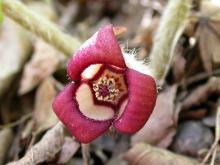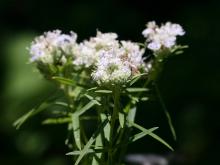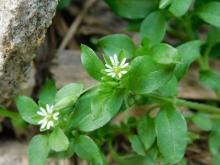Wildflowers, Grasses and Other Nonwoody Plants
Media

Species Types
Scientific Name
Claytonia virginica
Description
Our most widely distributed early spring flower, spring beauty has 5 white or pink petals with distinct pink veining, and 5 pink anthers. The narrow, bladelike leaves are fleshy. These flowers often grow in abundance, covering a patch of ground with the beauty of spring.
Media

Species Types
Scientific Name
Perilla frutescens
Description
Introduced as an ornamental, beefsteak plant is native to Asia. It is common in moist or dry wooded bottomlands, open valley pastures, and along trails, railroads, and roadsides. It spreads invasively in our state.
Media

Species Types
Scientific Name
Lamium amplexicaule
Description
In early spring, henbit carpets entire fields with the pinkish-purple of its small flowers. This nonnative mint spreads abundantly but causes few problems. It has shallow roots and fades before crops begin to grow.
Media

Species Types
Scientific Name
Asarum canadense
Description
In spring, wildflower lovers locate wild ginger by looking for its unique, hairy, heart-shaped leaves, then by stooping to view the small, three-parted brown flowers that form between the leaf bases, close to the ground.
Media

Species Types
Scientific Name
Blephilia ciliata
Description
Square, unbranching stems, opposite leaves, two-lipped flowers, and a mild minty fragrance are clues Ohio horsemint is in the mint family. Tight, rounded flower clusters are stacked atop one another at the stem tips.
Media

Species Types
Scientific Name
Prunella vulgaris
Description
A square-stemmed plant with opposite leaves, self-heal bears two-lipped blue, lavender, or violet flowers in a cylindrical head. We have two varieties of self-heal in Missouri, one native and one introduced.
Media

Species Types
Scientific Name
Monarda bradburiana (sometimes M. russeliana)
Description
Also called horsemint and wild bergamot, Bradbury beebalm is a showy, fragrant plant that is a favorite of native plant gardeners. It’s also a favorite of Missouri’s butterflies!
Media

Species Types
Scientific Name
Valerianella radiata
Description
At first glance, you might overlook corn salad, except for the large colonies it often forms. The young leaves can be eaten as a salad green, hence the name.
Media

Species Types
Scientific Name
Pycnanthemum tenuifolium
Description
Slender mountain mint has smooth, square stems, opposite, narrow leaves, and dense heads of 2-lipped white (or lavender) flowers. Aromatic and minty, it can be grown at home in the herb garden, and its leaves used for seasoning food.
Media

Species Types
Scientific Name
Stellaria media
Description
Common chickweed, native to Europe, has been introduced nearly worldwide and is a familiar garden weed in Missouri. It forms spreading mats on the ground and has small flowers with 5 petals, each deeply lobed making it look like 10.
See Also
About Wildflowers, Grasses and Other Nonwoody Plants in Missouri
A very simple way of thinking about the green world is to divide the vascular plants into two groups: woody and nonwoody (or herbaceous). But this is an artificial division; many plant families include some species that are woody and some that are not. The diversity of nonwoody vascular plants is staggering! Think of all the ferns, grasses, sedges, lilies, peas, sunflowers, nightshades, milkweeds, mustards, mints, and mallows — weeds and wildflowers — and many more!





















